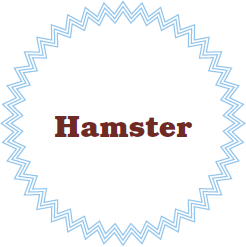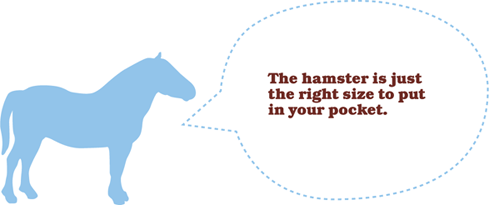
The word hamster comes from the German hamstern meaning ‘to hoard’. Hamsters can hoard an enormous amount of food in their cheek pouches and have even been known to hide their pups in their pouches if they sense danger. They make lovely pets, although ours were a bit unrewarding – they slept all day and spent all night noisily pounding around on their wheel. Apparently Sid Vicious was named after Johnny Rotten’s hamster.

If you fill the hamster with lentils he will sit in your hand like the real thing.
Height: 10cm (4in)
Width: 6cm (2½in)
Pair of 3¼mm (US 3) knitting needles
Pair of 2¼mm (US 1) knitting needles
15g (½oz) of Rowan Kidsilk Haze Trio in Snowberry 790 (sn)
5g (⅛oz) of Rowan Wool Cotton in Tender 951 (te) for nose and paws
Tiny amount of Rowan Pure Wool 4ply in Black 404 (bl) for eyes
Fishing line for whiskers
Lentils for stuffing
See here.
See for Wrap and Turn Method.

With 3¼mm (US 3) needles and sn, cast on 1 st.
Row 1: Inc knitwise. (2 sts)
Row 2: Knit.
Row 3: [Inc knitwise] twice. (4 sts)
Beg with a k row, work 2 rows st st.
Row 6: K4, cast on 10 sts. (14 sts)
Row 7: P14, cast on 10 sts. (24 sts)
Work 6 rows st st.
Row 14: K5, inc, k12, inc, k5. (26 sts)
Row 15: Purl.
Row 16: K5, inc, k14, inc, k5. (28 sts)
Work 5 rows st st.
Row 22: K2tog, k7, k2tog, k6, k2tog, k7, k2tog. (24 sts)
Work 5 rows st st.
Row 28: K2tog, k6, k2tog, k4, k2tog, k6, k2tog. (20 sts)
Work 3 rows st st.
Row 32: K2tog, k16, k2tog. (18 sts)
Work 3 rows st st.
Row 36: K14 wrap and turn (leave 4 sts on left-hand needle unworked).
Row 37: Working top of head on centre 10 sts only, p10, w&t.
Row 38: K10, w&t.
Row 39: P10, w&t.
Row 40: K10, w&t.
Row 41: P10, w&t.
Row 42: K across all sts. (18 sts in total)
Row 43: P2tog, p14, p2tog. (16 sts)
Row 44: K12, w&t (leave 4 sts on left-hand needle unworked).
Row 45: P8, w&t.
Row 46: K8, w&t.
Row 47: P8, w&t.
Row 48: K across all sts. (16 sts in total)
Row 49: P2tog, p2, p2tog, p4, p2tog, p2, p2tog. (12 sts)
Row 50: K2, k2tog, k4, k2tog, k2. (10 sts)
Row 51: [P2tog] 5 times. (5 sts)
Row 52: K2tog, k1, k2tog. (3 sts)
Row 53: P3tog and fasten off.
(make 2 the same)
With 3¼mm (US 3) needles and sn, cast on 5 sts.
Beg with a k row, work 4 rows st st.
Row 5: K2tog, k1, k2tog. (3 sts)
Row 6: P3tog and fasten off.
(make 2 the same)
With 2¼mm (US 1) needles and te, cast on 5 sts.
Work 4 rows st st.
Row 5: K2tog, k1, k2tog. (3 sts)
Work 2 rows st st.
Row 8: P3tog and fasten off.
(make 2 the same)
With 2¼mm (US 1) needles and te, cast on 3 sts.
Beg with a k row, work 3 rows st st.
Cast (bind) off.
SEWING IN ENDS Sew in ends, leaving ends from cast on and cast (bound) off rows for sewing up.
BODY With RS together, starting after tail (from row 6), sew up body, leaving a 2.5cm (1in) gap.
STUFFING Stuff head and top of body firmly, adding lentils to bottom of body for weight. Sew up gap.
NOSE With te, embroider 3 parallel satin stitches, positioned as in photograph.
EYES With bl, sew 3-loop French knots, positioned as in photograph.
PAWS Sew back paws to underside of body, with RS facing up, approx 1 st each side of centre seam. Sew front paws, as photograph, approx 1st either side of centre seam.
EARS Attach ears to top of head, with RS facing forwards and with 4 sts between.
WHISKERS Cut 3 x 8cm (3in) lengths of fishing line and thread through cheeks. Trim.

PAWS
The hamster has tiny front paws sewn to the front of his body.